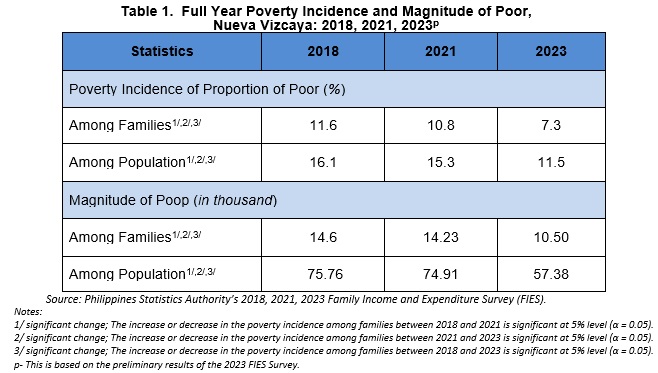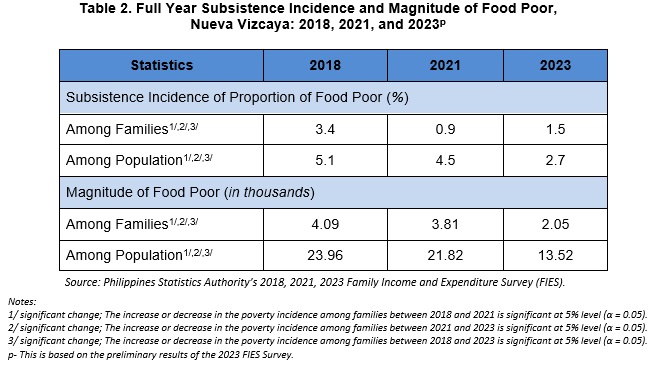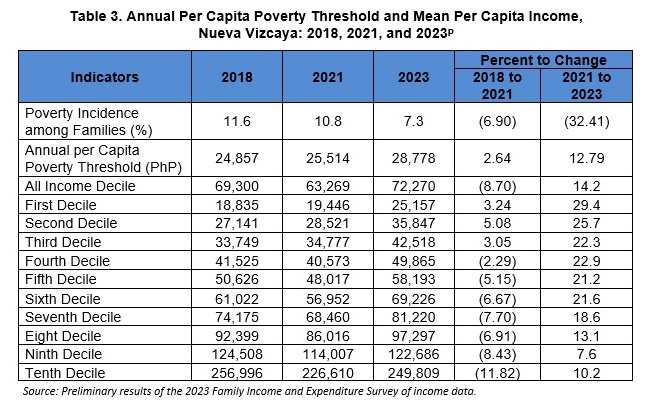Poverty Incidences and Magnitude of Poor Continuously Declined since 2018.
According to the preliminary results of the 2023 Family Income and Expenditure Survey (FIES), Nueva Vizcaya’s poverty incidence among families was recorded at 7.3 percent. This means that there are approximately 7 in every 100 families who have an income that is insufficient to buy their minimum basic food and non-food needs. The poverty incidences for 2023 are lower compared to the poverty incidences of 2018 and 2021 by 11.6 percent and 10.8 percent, respectively. Among individuals, the poverty incidence was 11.5 percent, or almost 12 in every 100 Novo Vizcayanos have a minimal income that is insufficient to obtain their minimum basic food and non-food needs. (Table 1)

On the other hand, subsistence incidence of proportion of food poor in Nueva Vizcaya was posted at 1.5 percent for 2023, higher compared to 0.9 percent of year 2021, which implies that roughly 2 in every 100 families have an income that is insufficient to meet their basic food needs. Among individuals, 2.7 percent of the total population in Nueva Vizcaya whose capita per income was not enough to cover their basic food needs. (Table 2)

Thresholds and Income Constantly Increased.
The poverty threshold is the minimum income level needed for a family or individual to meet their needs (basic food and non-food). A family of five in the province of Nueva Vizcaya in 2023 was required to have a minimum of PhP11,990.00 per month to acquire their basic food and non-food needs. In comparison to the poverty threshold in the year 2021 (Php10,630.00), the poverty threshold of 2023 was 12.79 percent higher.Meanwhile, at least Php8,360.00 per month was needed for a family of five to cover their basic food needs. The food threshold for 2023 was higher than 2018 (PhP7,230.00) and 2023 (Php7,420.00), or by 15.63 percent and 12.66 percent, respectively. (Figure 1)


As a result of adjustments in the poverty threshold and income levels from 2021 to 2023, the poverty indices among families decreased to 7.3 percent in 2023, 32.41 percent lower than 10.8 percent in 2021. In contrast, the poverty threshold in 2023 increased to PhP28,778.00, or by 12.79 percent in comparison with the year 2021. The mean per capita income rapidly grew by 12.79 percent from the year 2021 to 2023, compared to 2.64 percent from 2018 to 2021. (Table 3)
Technical Notes
The poverty statistics is based on Republic Act 8425 of 1997 or the Social Reform and Poverty Alleviation Act, under this Act the National Economic and Development Authority (NEDA) defined poor as individuals and families whose income fall below the poverty threshold and/or cannot afford in a sustained manner to provide their minimum basic needs of food, health, education, housing and other essential amenities of life. Accordingly, from this definition, our current poverty statistics are based on income.
The Family Income and Expenditure Survey (FIES) is a nationwide survey of households undertaken by the Philippine Statistics Authority (PSA) every two years. It is the main source of data on family income and expenditure, which includes, among others, levels of consumption by item of expenditure as well as source of income in cash and in kind. The results of FIES are used for policy and planning purposes, thus, examination of the quality of the survey is highly important.
CHOLLY L. BAYON
Chief Statistical Specialist
